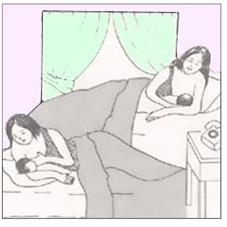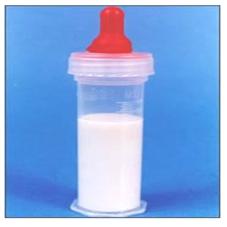미숙 신생아들에게 모유수유나 인공영양을 먹일 때, Breast feeding or formula feeding for premature infants

사진 4-9. 크고 건강한 미숙 신생아들에게는 모유를 수유하는 방법은 만삭 신생아에게 모유를 수유하는 것과 거의 같게 할 수 있다.
Copyright ⓒ 2011 John Sangwon Lee, MD., FAAP

사진 4-10. 아주 작은 미숙 신생아들에게 먹일 때 이런 종류의 특수 인공영양 우유병을 이용할 수 있다.
Copyright ⓒ 2011 John Sangwon Lee, MD., FAAP
- 출생 시 체중이 2~2.5kg이거나 그 이상 되는 건강하고 큰 미숙 신생아들에게는 모유를 수유하는 방법이나 인공영양을 먹이는 방법은 만삭에 태어난 정상 신생아들에게 모유나 인공영양을 먹이는 방법과 별로 다른 것이 없다.
- 일반적으로 임신 35~37주에 태어난 미숙 신생에게는 출생 후 대체로 건강하면 바로 모유수유를 할 수 있다. 그리고 바로 인공영양을 먹일 수 있다.
- 그러나 출생 시 체중이 2kg이거나 그보다 더 작은 미숙 신생아들이나 저체중 신생아들에게 모유수유를 하거나 인공영양을 먹이는데 더 많은 피딩 기술(식이기술)과 육아 지식이 필요하다.
- 때로는 소아과 전문의나 간호사의 도움을 받고 인공영양을 먹이어야 할 때도 있다.
- 임신 35~37주경 태어난 미숙 신생아들 중 일부는 모유를 보통으로 잘 수유할 수 없을 때도 있다.
- 이때는 아기 스스로 엄마의 젖꼭지를 잘 빨아 모유를 잘 먹을 수 있을 때까지 손이나 착유펌프로 젖을 짜서 우유병으로 아기에게 먹일 수 있다.
- 게다가 출생 시 체중이 1.5kg 이하 되는 아주 작은 미숙 신생아들의 대부분은 엄마의 젖꼭지나 우유병 꼭지를 제대로 빨 수 있는 힘이 없는 때도 많다.
- 그래서 우유병 꼭지의 구멍이 좀 더 크게 뚫린 우유병 꼭지로 인공영양을 먹일 때도 있고 더 쉽게 먹을 수 있게 만든 미숙아 전용 우유병과 우유병 꼭지를 이용해 먹일 수 있다.
- 때로는 손이나 착유펌프로 짠 모유나 인공영양을 피딩 튜브(튜브 영양법)를 이용해서 아주 작은 미숙신생아들에게 먹이기도 하고 짠 모유를 특별히 만든 우유병 꼭지를 이용해서 특별한 우유병으로 먹이기도 한다.
- 모유는 소화가 비교적으로 잘 되고 감염병을 예방하는 데도 더 좋기 때문에 가능한 한 미숙 신생아들에게 모유를 수유하는 것이 좋다.
- 대부분의 미숙아들은 만삭 신생아들에 비해 젖을 먹은 후 인공영양을 먹은 후 잘 넘길 수 있고 때로는 생리적 위식도 역류가 있어 잘 넘길 수 있다.
- 또한 구토 물이 기관이나 기관지, 폐 속으로 흡인되어 흡인성 폐렴이 더 쉽게 생길 수 있다. 이런 저런 이유로 미숙 신생아들을 양호하는 데는 더 많은 사랑과 인내, 관심과 육아지식이 더 많이 필요하다.
Breast feeding or formula feeding for premature infants 미숙 신생아들에게 모유수유나 인공영양을 먹일 때

Photo 4-9. For large, healthy, premature newborns, breastfeeding can be done in almost the same way as for full-term newborns. Copyright ⓒ 2011 John Sangwon Lee, MD., FAAP

Photo 4-10. Special artificial nutritional milk bottles of this type can be used when feeding very small, premature newborns. Copyright ⓒ 2011 John Sangwon Lee, MD., FAAP
The method of breastfeeding or feeding artificial nutrition to healthy and large immature newborns weighing 2~2.5kg or more at birth is not very different from the method of feeding breastmilk or artificial nutrition to normal newborns born at full term.
In general, immature newborns born at 35-37 weeks of pregnancy can breastfeed immediately after birth if they are generally healthy.
And you can feed artificial nutrition right away. However, more feeding skills (diet skills) and parenting knowledge are required to breastfeed or feed artificial nutrition to premature and underweight newborns weighing 2kg or less at birth.
Sometimes it is necessary to receive artificial nutrition with the help of a pediatrician or nurse. Some of the immature newborns born around 35-37 weeks of pregnancy may not be able to breastfeed normally.
At this time, the baby is unable to suck breast milk, and then the mother squeezes her breast to have breast milk with her hand or a milking pump and feed the baby with a bottle of breast milk until the baby is able to suck the mother’s nipples well and eat well.
In addition, most of the very small immature newborns weighing less than 1.5 kg at birth often do not have the power to properly suck the mother’s nipple or bottle nipple.
Therefore, artificial nutrients are sometimes fed with a milk bottle teat with a larger hole in the milk bottle teat and can be fed using a milk bottle exclusively for premature infants and a milk bottle teat made to make eating easier.
Sometimes, breast milk or artificial nutrition squeezed by hand or a milking pump is fed to very small immature infants using a feeding tube (tube nutrition method), and the squeezed breast milk is fed with a special bottle using a special milk bottle nipple. Breastfeeding is recommended to premature newborns as much as possible, as breast milk is relatively well digested and better at preventing infectious diseases.
Compared to full-term newborns, most premature babies can pass through artificial nutrition after breastfeeding, sometimes with physiological gastroesophageal reflux. In addition, vomiting water is aspirated into the trachea, bronchi, or lungs, making it easier to develop aspiration pneumonia. For these and other reasons, it takes more love, patience, attention and parenting knowledge to be good for premature newborns.
출처 및 참조 문헌
- Nelson Textbook of Pediatrics 22ND Ed
- The Harriet Lane Handbook 22ND Ed
- Growth and development of the children
- Red Book 32nd Ed 2021-2024
- Pediatric Nutritional Handbook American Academy of Pediatrics
- 소아가정간호백과–부모도 반의사가 되어야 한다, 이상원 저
- The pregnancy Bible. By Joan stone, MD. Keith Eddleman,MD
- Neonatology Jeffrey J.Pomerance, C. Joan Richardson
- Preparation for Birth. Berverly Savage and Dianna Smith
- 임신에서 신생아 돌보기까지. 이상원
- Breastfeeding. by Ruth Lawrence and Robert Lawrence
-
- www.drleepediatrics.com 제1권 소아청소년 응급 의료
- www.drleepediatrics.com 제2권 소아청소년 예방
- www.drleepediatrics.com 제3권 소아청소년 성장 발육 육아
- www.drleepediatrics.com 제4권 모유,모유수유, 이유
- www.drleepediatrics.com 제5권 인공영양, 우유, 이유식, 비타민, 미네랄, 단백질, 탄수화물, 지방
- www.drleepediatrics.com 제6권 신생아 성장 발육 육아 질병
- www.drleepediatrics.com제7권 소아청소년 감염병
- www.drleepediatrics.com제8권 소아청소년 호흡기 질환
- www.drleepediatrics.com제9권 소아청소년 소화기 질환
- www.drleepediatrics.com제10권. 소아청소년 신장 비뇨 생식기 질환
- www.drleepediatrics.com제11권. 소아청소년 심장 혈관계 질환
- www.drleepediatrics.com제12권. 소아청소년 신경 정신 질환, 행동 수면 문제
- www.drleepediatrics.com제13권. 소아청소년 혈액, 림프, 종양 질환
- www.drleepediatrics.com제14권. 소아청소년 내분비, 유전, 염색체, 대사, 희귀병
- www.drleepediatrics.com제15권. 소아청소년 알레르기, 자가 면역질환
- www.drleepediatrics.com제16권. 소아청소년 정형외과 질환
- www.drleepediatrics.com제17권. 소아청소년 피부 질환
- www.drleepediatrics.com제18권. 소아청소년 이비인후(귀 코 인두 후두) 질환
- www.drleepediatrics.com제19권. 소아청소년 안과 (눈)질환
- www.drleepediatrics.com 제20권 소아청소년 이 (치아)질환
- www.drleepediatrics.com 제21권 소아청소년 가정 학교 간호
- www.drleepediatrics.com 제22권 아들 딸 이렇게 사랑해 키우세요
- www.drleepediatrics.com 제23권 사춘기 아이들의 성장 발육 질병
- www.drleepediatrics.com 제24권 소아청소년 성교육
- www.drleepediatrics.com 제25권 임신, 분만, 출산, 신생아 돌보기
- Red book 29th-31st edition 2021
- Nelson Text Book of Pediatrics 19th- 21st Edition
- The Johns Hopkins Hospital, The Harriet Lane Handbook, 22nd edition
- 응급환자관리 정담미디어
-
소아가정간호백과–부모도 반의사가 되어야 한다, 이상원
-
Neonatal Resuscitation American heart Association
-
Neonatology Jeffrey J.Pomerance, C. Joan Richardson
-
Pediatric Resuscitation Pediatric Clinics of North America, Stephen M. Schexnayder, M.D.
-
Pediatric Critical Care, Pediatric Clinics of North America, James P. Orlowski, M.D.
-
Preparation for Birth. Beverly Savage and Dianna Smith
-
Infectious disease of children, Saul Krugman, Samuel L Katz, Ann A. Gershon, Catherine Wilfert
- Pediatric Nutritional Handbook American Academy of Pediatrics
- 소아가정간호백과–부모도 반의사가 되어야 한다, 이상원
- The pregnancy Bible. By Joan stone, MD. Keith Eddleman, MD
- Neonatology Jeffrey J. Pomerance, C. Joan Richardson
- Preparation for Birth. Beverly Savage and Dianna Smith
- 임신에서 신생아 돌보기까지. 이상원
- Breastfeeding by Ruth Lawrence and Robert Lawrence
- Infectious disease of children, Saul Krugman, Samuel L Katz, Ann A. Gershon, Catherine Wilfert
- 제4권 모유, 모유수유, 이유 참조문헌 및 출처
- 제5권 인공영양, 우유, 이유, 비타민, 단백질, 지방 탄수 화물 참조문헌 및 출처
- 제6권 신생아 성장발육 양호 질병 참조문헌 및 출처
- 소아과학 대한교과서
|
Copyright ⓒ 2015 John Sangwon Lee, MD, FAAP 미국 소아과 전문의, 한국 소아청소년과 전문의 이상원 저 “부모도 반의사가 되어야 한다”-내용은 여러분들의 의사로부터 얻은 정보와 진료를 대신할 수 없습니다. “The information contained in this publication should not be used as a substitute for the medical care and advice of your doctor. There may be variations in treatment that your doctor may recommend based on individual facts and circumstances. “Parental education is the best medicine.” |